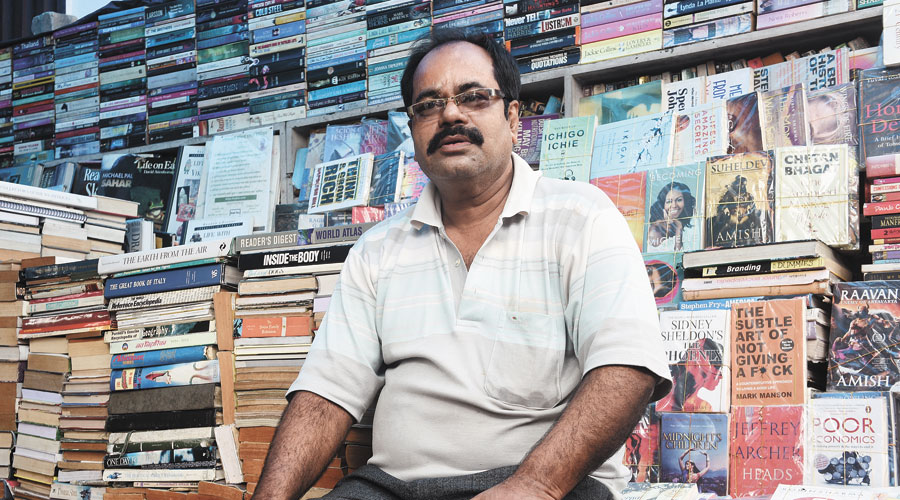Lives of others | Koyal can be considered a minor landmark, literally

You have seen him perched on his stool for the last 30 years or more, like patience on a monument, not exactly smiling at grief, but slightly frowning perhaps and looking contemplatively at the unending stream of humanity that is Gariahat Road.
If you are walking from Golpark to Gariahat, along the right footpath, Tapas Kumar Koyal’s is the first old books stall that you come across as you cross the first lane on your left. The cluster of second-hand books stalls here is south Calcutta’s answer to College Street’s purono boi para; smaller it is, but no less significant.
Koyal, 52, can be considered a minor landmark, literally. As he presides over his collection, arranged neatly according to demand, he grabs the passer-by in whose eyes he sees the slightest flicker of interest, and with practised ease quickly takes the potential buyer through a tour of his titles, starting at Amish, the blockbuster, then hopping on to Shashi Tharoor, Chetan Bhagat and then to Murakami. But if this pecking order fails to produce the desired effect, Koyal takes you to his other stuff, kind of hidden among the pile that is hidden behind the Amishes and the Bhagats. And there, in those columns made of books, you might find that one book that can change your life, slightly or more — an old copy of George Meredith’s The Egoist in surprisingly good condition or Voices from Chernobyl, long before its author became more than an unpronounceable name in these parts of the world.
Koyal has no idea how many lives he has changed.
He is surprised that anyone would want to interview him at all. He started work at the bookstall when he was about 12, having to leave school midway. The stall he now looks after belonged to his father.
Originally residents of Sarisha, Diamond Harbour, in South 24-Parganas, Koyal, as a child, had come over with his other family members to Calcutta, to join his father. They used to live in a room in Purna Das Road. Koyal was enrolled at Lake View School. He still lives in that room. His wife and children live in their family home in Sarisha.
“I had to give up school after Class VIII,” says Koyal. By that time his two other brothers were already helping their father, who would eventually own three stalls, two on the footpath and one a shop on the ground floor of a building on the other side of the lane. Their father has passed away. The three brothers now manage the business. Between them they have the stall where Koyal sits and two others, the old shop in the building and another in the same building.
The three stalls hold thousands of books together.
From the time Koyal has been at the stall, the city has changed much. And so has Gariahat. “I saw the Meghamallar building (one of the oldest highrises in the area) come up.” He was struck down by Operation Sunshine, like other hawkers in the city. Slowly, like his neighbours in Gariahat, he came back. “But previously I had a proper stall, with doors, like they have in College Street. This stall is only benches and my stool,” he says.
He saw the Gariahat boulevard getting razed and the Gariahat flyover springing up. He misses the boulevard, but considers the flyover a good idea.
And he has felt the onslaught of the availability of books online. “Book sales have gone down about 50 per cent compared to 20 years ago,” he said. And Indian writers writing in English have replaced foreign writers.
“Earlier people wanted Ludlum, Sidney Sheldon, Harold Robins and Jeffrey Archer. Now it is Amish. All his books do well.” And of course Bhagat and Tharoor. And the occasional foreigner like Michelle Obama, whose autobiography is doing well here too, he said.
All available at less than half the market price or less at his stall.
Old favourites, however, have not been abandoned, insists Koyal. “Ludlum, Sidney Sheldon, Harold Robbins and Jeffrey Archer are still popular,” he said, pointing at rows of these writers at one of the shops in the building. He points to another, longer row, filled with another eternal: Mills and Boons.
Once the M&Bs here were the lifeline for many pre-millennial young women: for as little as Rs 10 as deposit and Rs 5 as reading fees, one title could be borrowed for a month. The old book stalls functioned as lending libraries too. They still do.
“The deposit is Rs 100, the reading charges Rs 30 per month,” he said. One wonders if the readers remain the same in number.
The supply of old books was never interrupted, though. “We have a network. Those who buy newspapers from houses are often sold old books. If there are collections, the owner sends me a word through them,” Koyal said.
Many of them come from old houses where old families live. These days when old buildings are being brought down and replaced by multi-storeyeds, especially in the areas around Golpark, many families tend to sell their old collections.
The collections range from Encyclopaedia Britannica to finely produced art books to collections on photography. But who buys them in this age, especially encyclopaedias? “People do, sometimes only to decorate their houses,” Koyal said. Are his children interested in joining his business? “Why should they?” asks Koyal. “They are getting educated.” His daughter is in college and his son is still in school.
source: http://www.telegraphindia.com / The Telegraph Online / Home> West Bengal> Calcutta / by Chandrima S Bhattacharya / November 02nd, 2020